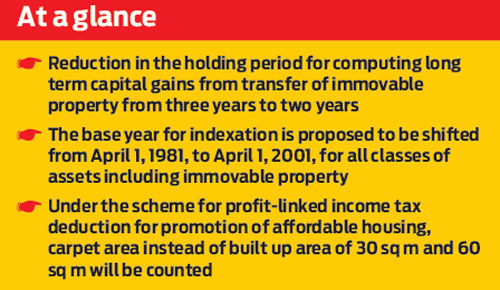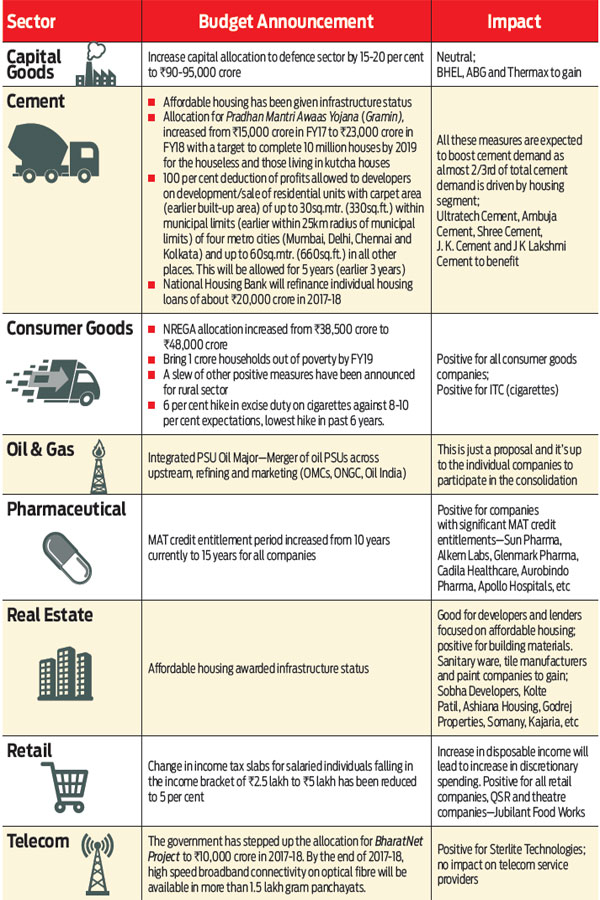Budget 2017: Housing dream gets real
For scores of Indians, the dream to own a house may just have got the necessary push with this Budget

A 2016 report on the affordable housing space by real estate consultancy Cushman & Wakefield, indicated a 100 per cent rise in new launches in the first half of 2016 (H1 2016), in the affordable housing segment. If one goes by the announcements made by finance minister Arun Jaitley in his 2017 Budget speech, the thrust on affordable housing has the potential to fulfil every Indian’s aspiration of owning a house. Industry players in the segment and observers of the sector believe that granting infrastructure status to the segment will bring the housing dream within many home-seekers’ reach.
“Easy and dedicated access to institutional financing, higher limit on external commercial borrowings will attract more investments and assure sustained growth of affordable housing in India, making it the core driving segment for real estate,” says Brotin Banerjee, CEO and MD, Tata Housing. The speculative trend in the real estate sector ended post the financial crisis in 2008, which also changed for the good lending norms for both builder and buyers. Several delayed projects also changed the appetite for buyers from bigger homes to smaller homes, as realty buyers started scouting for homes instead of speculators.
Read- How will Budget 2017 affect your finances?
Drivers of change
The definition of what qualifies as affordable housing and preferential lending to this segment have resulted in an increased demand for affordable homes. Introducing profit-linked income tax exemption for promoters of affordable housing projects in the Budget is a boost for developers. “This is very significant,” says Anuj Puri, chairman and country head, JLL India. “It will provide the vital budget housing segment with cheaper sources of finance including, but not restricted to, ECBs (external commercial borrowings). Also, re-financing of housing loans by NHBs (National Housing Bank) can give a leg up to the sector.”
The 30-60 sq m limit measured previously as built-up area to now carpet area will bring more number of units under the revised description. “The 30 sq m limit will only be applicable within the corporation limits of the four major metros. For fringe areas of these metros and all other cities, it will be 60 sq m on carpet area. This will effectively serve to increase the number of projects falling under this segment,” explains Puri.

Where to invest now?
Stock markets have reacted positively to the Budget. Both the Nifty and the Sensex closed Budget day with gains and the trend continued a day later as this edition went into print. Stock markets were buoyant because the Budget stuck to its broad fiscal consolidation roadmap with fiscal deficit at 3.2 per cent of GDP.
Some of investors’ expectations were met such as a fiscal push for infrastructure investments as well as tax breaks in hands of consumers and corporates. All these outcomes were met and the fear on introduction of capital gains tax on equity holdings was nullified with no change in the taxation status. Further, the Budget stated that the budgeted expenditure on infrastructure has been increased by 25 per cent, something that market experts welcomed.
Read- Budget 2017: What Budget 2017 has in store for you?
Equity gains
The expectation that interest rates will remain low will make commercial borrowings by private sector very competitive. Investors in duration funds can continue holding their position for a few months more to take the full benefit of easing yields but change in interest rates should be tracked closely. The sign of money flow into equity markets is strong, which will only go up with more people shifting towards financial assets over physical assets.
The sector to watch out definitely is infrastructure. Any activity in the infrastructure space will have a trickledown effect in the economy. The impact is visible on HFC stocks, who are financiers to the housing segment which has been granted the ‘infrastructure’ status. Stocks of developers who are players in the affordable housing segment are already benefiting from the stock market momentum.
Other than infrastructure, the sectors that could gain from the Budget announcements include cement, consumer goods, pharma and real estate. Another theme to look out for is the IT sector, more so from the US political perspective, which is currently at a low valuation, and offers opportunity for good risk adjusted returns.
Shares of automobile companies and PSUs also witnessed decent gains, on back of announcements to boost rural incomes and ambitious targets to raise revenue through disinvestment.
The implementation of GST from July 2017, may cause some hiccups at the implementation process but such teething troubles will get resolved in a couple of quarters. Likewise, the rural focus is a positive outcome to selectively invest in stocks that will gain from activity in the rural sector.
Now that the Budget is behind us, it is time to shift the focus to execution, corporate earnings and global cues to factor in when selecting stocks and entering sectors. The Trump era is already posing trouble for the IT sector, and one should watch the market movements more closely.










